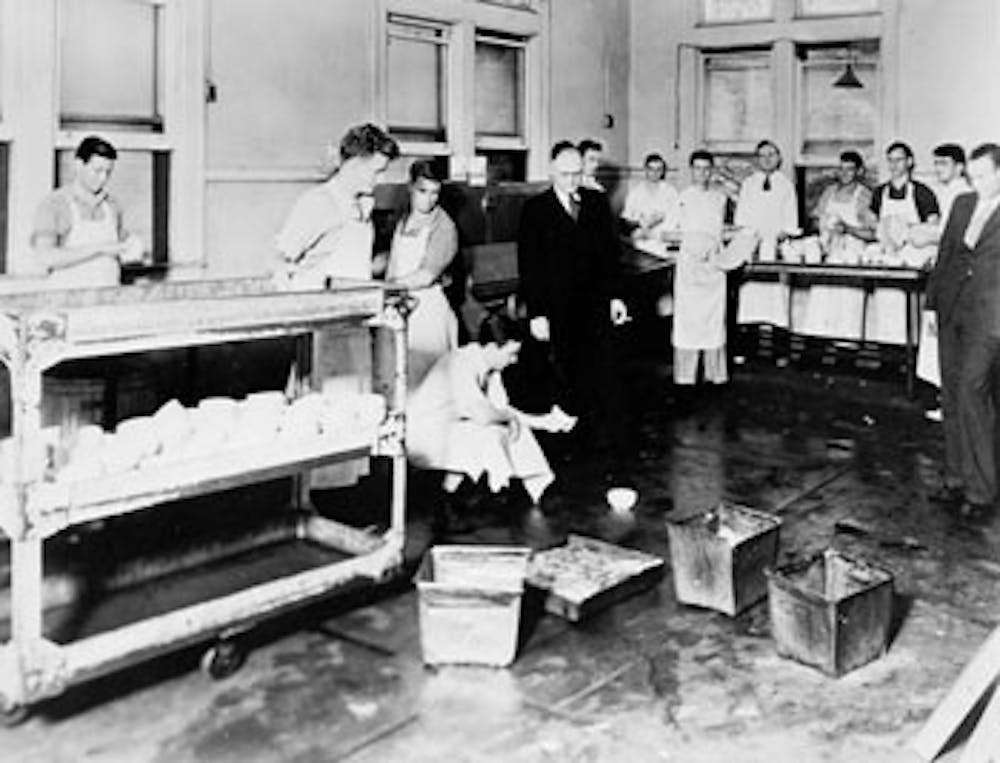In 1929 a pound of butter at Shield's Grocery on Franklin Street cost $0.56. Chapel Hill was a town on the rise. The roads had just been paved and population was growing.
By 1930 that same pound of butter cost $0.22.
Faced with the severe financial crisis" residents and students banded together to overcome obstacles during the Great Depression.
""The thing that kept people here and kept people going was Chapel Hillitis" said '30s author Josephina Niggli in 1953. Something about the town just grabbed people immediately and kept them there no matter what" she said.
In the town
Chapel Hill stormed through the 1920s with rapid growth. Construction in 1927 totaled more than $750,000.
Franklin Street had just been paved and was booming.
At the University, a $500,000 deal had just been approved for the construction of Graham Memorial, and $100,000 for the Bell Tower.
But after the crash, the town slowed down.
The Pickwick Theatre — located where Cosmic Cantina and Johnny T-shirt reside today — was a staple of student life, showing the latest silent films.
It was always full on weekends" said Pickwick pianist Mabel Thompson to the Chapel Hill Herald in 1953. Never a seat in the place. There were constant yells" flying peanuts and ribald comments on the picture from the students.""
The theater was the first victim of the Depression" closing in 1931 after ticket sales dwindled.
The crisis continued to engulf Chapel Hill. John Foushee elected mayor in 1933 was presented with a budget of $27918 — 12 percent of what it was in 1929.
Franklin Street once home to numerous pharmacies and grocers saw most stores close by the end of the 1930s. Franklin became a home to beggars and handout lines.
Stores" students and organizations provided food and clothing for more than one fourth of the town's population.
""My husband said it was always common to see people begging at the doors of businesses"" said Georgia Kyser, a resident of The Cedars of Chapel Hill.
It was everywhere"" she said. You couldn't avoid it.""
Jobs became increasingly scarce" forcing many residents to use underhanded tactics to generate income.
A town ordinance was passed in 1933 to prohibit the sale of unauthorized Tar Heel merchandise on game days.
Hitting the University
The Depression came down on the University just as heavily as it did on the town.
Having initiated almost $1 million in new construction before the market crash" the University was forced to cut back.
A proposal to cut faculty salaries drew a combative response — from students.
The Class of 1930 demanded that the salaries of faculty members remain the same and offered to give up commencement ceremonies to alleviate ""unnecessary spending.""
""We offer to you any and all commencement celebrations in an effort to protect the salaries and well-being of those who have provided such an outstanding education"" an anonymous senior wrote to University President Frank Porter Graham.
The Daily Tar Heel was operating at a loss of $5,000 in 1931, nearly $70,000 adjusted for inflation.
Somehow, students found ways to make and save money.
Some methods were more honest than others. Many out-of-state student falsified addresses to avoid paying the steep out-of state-tuition of $175 — about $2,362 in today's money.
One more desirable job was bussing tables in the dining halls. In 1931, more than 350 students applied for 73 spots to work for $0.25 an hour — about $3.50 in today's money — and a free meal at the end of the day.
The University let students live in Swain Dining Hall for $25 a semester.
Out of the rut
The climb out of the depression finally began with New Deal reforms after 1937. The Works Progress Administration restarted construction on many abandoned projects and helped build 10 new structures on campus and expand the Carolina Inn.
Today, Franklin Street holds few reminders of the Depression era. Sutton's Drug Store and The Carolina Coffee Shop are the only remaining establishments from the '30s.
Sutton's was a popular hangout and survived largely because of owner James Sutton's lack of stock investment before the crash.
Carolina Coffee Shop's iconic status among Chapel Hill residents allowed it to survive, former owner George Livas said in an interview with the Chapel Hill museum.
Our landlords told us that we could pay the rent whenever we had the money as long as we stayed open"" Livas said. The restaurant offered free meals to students and the needy for a period of time.
That's how we survived.""
Contact the Features Editor at features@unc.edu.
Chapel Hill in the depression

During the Great Depression" UNC students work as dishwashers in the dining halls. Competition for the jobs was fierce as students worked to earn money to pay tuition. In 1931 more than 350 students applied for 73 spots working for only 25 cents an hour ? approximately $3.50 today.



